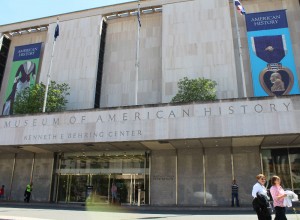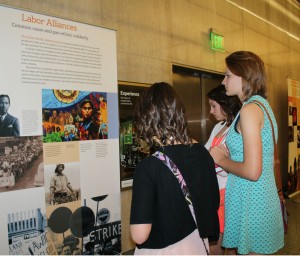Bulosan work leads Smithsonian’s Asian Pacific American exhibition

The Smithsonian’s National Museum of American History is one of 16 museums in the nation’s capital that draws more than 3 million visitors each year. PHOTOS by Jon Melegrito
WASHINGTON, D.C.–Acclaimed Filipino American writer Carlos Bulosan’s poem “I Want the Wide American Earth” crowns the Smithsonian’s banner exhibit honoring the more than 17 million Asian Pacific Americans in this country with a banner exhibit celebrating their history, culture and literary works.
For the first time since its founding in 1846, the Smithsonian’s National Museum of American History, the world’s largest museum, is putting a spotlight on Asian Pacific Americans as a group. The exhibition is inspired by a poem written by Bulosan (1913-1956), his tribute to the “proud builders and workers” is the museum’s theme for this year’s APA Heritage Month.
An excerpt from the poem reads: “Before the brave, before the proud builders and workers/
I say I want the wide American earth/For all the free./ I want the wide American earth for my people./
I want my beautiful land./I want it with my rippling strength and tenderness/Of love and light and truth/
For all the free.”
The Smithsonian’s Asian Pacific American Center selected Bulosan’s poem because it “tells the rich and complex stories of the very first Asian immigrants, including their participation in key moments in American history, such as building the American labor movement,” says Gina Inocencio, the center’s program specialist.
She notes that Bulosan, who came to America in search of opportunity, wrote about the hardship and discrimination that Filipino workers suffered. Other Asian immigrants, she points out, struggled against civil rights violations and legal exclusions like the Chinese and, in the case of Japanese Americans, unlawful detentions.
Unwavering faith
“And yet, Bulosan never wavered in his faith in America. Their struggles and triumphs are part of the American story, in all its diversity. Through this exhibit, we remind all Americans that the APA story is theirs to cherish and pass on to future generations,” explains Inocencio.

Courtney Wojciechowski of Saginaw, Michigan (right) and her classmates checking out the APA exhibit.
Images and illustrations reproduced on 30 panels take a sweeping look at this history across a multitude of diverse cultures and how they have shaped and been shaped by the course of the nation’s history. Each panel focuses on a specific historical period, from the very first Asian immigrants centuries ago to the complex challenges facing APA communities today.
Among the notable highlights: labor alliances, World War 11 and military service, Japanese-American internment, post-1965 immigration, representation in politics and civil rights struggles such as the fight to stop the eviction of elderly tenants from San Francisco’s I-Hotel in the 1960s.
“Ours is truly a quintessential American story,” says Konrad Ng, the center’s director. “Some chapters of our history are well known, such as the Chinese railroad workers or the internment of Japanese Americans during World War II. But countless others have been overlooked. Asian Americans are central to American history, from the Civil War to the Civil Rights Movements.”
Eye-opener
Among the more than three million who visit the Smithsonian every year were three high school students from Saginaw, Michigan who stopped by the APA exhibit the day after it opened. All three admitted not knowing anything at all about Asian Pacific Americans and their history in this country.
Courtney Wojciechowski, an 8th-grader whose great grandparents immigrated from Poland, says the exhibit “is very informative. It confirms that we are truly a nation of immigrants.” All three say they have classmates who are from the Philippines, Korea and China. “Now we know a little bit more about them,” adds Samantha Weber, who says her family’s roots are German.
A middle-aged couple from Orlando, Florida, were also fascinated by the exhibit. It was their first time to see the Smithsonian. “We have Filipino friends,” exclaims Tom Handel, “and I have tasted some of their food. But I didn’t know Filipinos have been in this country for more than a hundred years. You learn something every day.”
The exhibit, which opened May 4, will run through June 15 then travel to other major U.S. cities in the fall.
The first significant exhibition on a major Asian Pacific American group in any of the Smithsonian’s 16 museums was “Through My Father’s Eyes: The Filipino American Photographs of Ricardo Ocreto Alvarado (1914-1976),” at the National Museum of American History in 2002.
Least visible
In its review, The Washington Post noted that “Filipino Americans are perhaps the least visible immigrant group in America, often mistaken for Chinese, Japanese or Latinos. This despite the fact that they are the United States’ second-largest Asian group after Chinese, and federal immigration data indicate that the Philippines sends more immigrants to the United States than any other Asian land. Very little of their history in this country has been recorded. That’s partly what makes the Alvarado exhibition so compelling. The pictures of parties, weddings, baptisms, Communions, cockfights, pig roasts, beauty pageants, picnics and workplaces give a sense of what life must have been like for these people.”
In 2006, the Smithsonian Filipino American Centennial Commemoration marked 100 years of Filipino immigration to the United States with another significant exhibition, “Singgalot.” It was created by the Smithsonian with the University of Hawaii Department of Ethnic Studies. Dean Alegado of the University of Hawaii at Manoa and Franklin Odo, then director of the Smithsonian APA program, co-curated the exhibition.
“To have our story told in the Smithsonian is a big deal because it gives us huge visibility,” Inocencio states. “We are part of how our nation came to be. And we must, through our voices, also be part of collective efforts to meet the challenges that shape us.”














